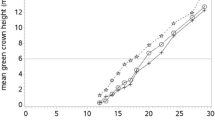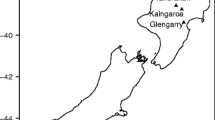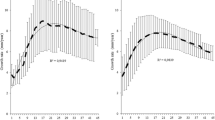Abstract
The influence of stand density on Douglas-fir [Pseudotsuga menziesii (Mirb.) Franco] is conceptually understood, but for wide spacings not well quantified, particularly in Europe. This study used 41 trees from 7 different locations in south-western Germany to compare important tree- and branch-level attributes across three different densities, namely 100, 200, and 1,200 stems ha−1. In general, there were only a few tree and branch attributes that were significantly different between the 100 and 200 ha−1 densities. Crown projection area and diameter of the thickest branches were the most important differences between the 100 and 200 ha−1 densities. The most obvious and significant differences in this study were between 100 and 1,200 ha−1 densities, where nearly every examined tree and branch attributes were statistically significant. However, relative sapwood area, the number of branches, branch angle, and the occurrence of spike knots were insensitive to stand density. Although the two lowest stand densities in this study represent rather extremely wide spacings, these results still have important implications for the development of effective thinning regimes for Douglas-fir in south-western Germany. Important management recommendations from this study include thinned stands should be maintained to at least 200 stems ha−1 to maintain high log quality and stand stability. Furthermore, even at stand densities exceeding more than 1,200 trees ha−1 planted trees, artificial pruning may even be necessary to produce high quality logs.




Similar content being viewed by others
References
Abetz P (1987) The “Solitary program 1987”. A contribution to a forestry related risk control. Allg Forst-u Jagdztg 45:1172. In German
Abetz P, Lässig P (1989) Great echo to the “Solitary program 1987”. Allg Forst-u Jagdztg 27:714–716. In German
Anonymous (1998a) Qualitative classification of softwood round timber—Part 1: Spruces and firs. European Committee for Standardization. prENV 1927–1. Brussels
Anonymous (1998b) European norm for sawn timber, EN 1912: European Committee for Standardization. Brussels
Anonymous (1998c) European norm for sawn timber, EN 388: European Committee for Standardization. Brussels
Anonymous (2003) Timber assortment according to carrying capacity, softwood timber. Beuth, Berlin. In German
Bamber RK, Fukazawa F (1985) Sapwood and heartwood: a review. For Abstr 46:567–580
Bösch B (2001) New tools for site indexing and growth in Baden-Württemberg. Wissenstransfer in Praxis und Gesellschaft—FVA Forschungstage 05–06 July 2001. Schriftenr Freiburger Forstliche Forsch 18:266–276. In German
Brix H, Mitchell AK (1983) Thinning and nitrogen fertilization effects on sapwood development and relationships of foliage quantity to sapwood area and basal area in Douglas-fir. Can J Res 13:384–389
Carter RE, Miller IM, Klinka K (1986) Relationships between growth form and stand density in immature Douglas-fir. For Chron 62:440–445
Curtis RO, Reukema DL (1970) Crown development and site estimates in a Douglas-fir plantation spacing test. For Sci 16:287–301
Ehring A, Kohnle U (2006) State of the coordinated Douglas-fir growing space experiment in Baden-Württemberg. Deutscher Verband Forstlicher Forschungsanstalten—Sektion Ertragskunde—Jahrestagung 29–31 May 2006, Staufen, 151–159. In German
Espinosa Bancalari MA, Perry DA, Marshall JD (1987) Leaf area—sapwood area relationships in adjacent young Douglas-fir stands with different early growth rates. Can J Res 17:174–180. doi:10.1139/x87-030
Flewelling JW, Collier R, Gonyea B, Marshall D, Turnblom E (2001) Height-age curves for planted stands of Douglas-fir, with adjustments for density. In: Stand Management Cooperative Working Paper 1. University of Washington, College of Forest Resources, Seattle, WA
FVA-BW (2004) Forest in Baden-Württemberg in 2002 and development since 1987 - The most important results from the Second National Inventory in Germany - Forest area and tree species composition. http://www.fva-bw.de/forschung/bui/bwi_erg_land.html. Accessed 1 February 2008 (in German)
Gersonde RF, O’Hara KL (2005) Comparative tree growth efficiency in Sierra Nevada mixed-conifer forests. For Ecol Manage 219:95–108
Grier CC, Waring RH (1974) Conifer foliage mass related to sapwood area. For Sci 20:205–206
Hein S, Mäkinen H, Yue C, Kohnle U (2007) Modelling branch characteristics of Norway spruce from wide spacings in Germany. For Ecol Manage 242:155–164. doi:10.1016/j.foreco.2007.01.014
Hein S, Weiskittel AR, Kohnle U (2008) Branch characteristics of widely-spaced Douglas-fir in south-western Germany: comparison of modelling approaches and geographic regions. For Ecol Manage 256:1064–1079. doi:10.1016/j.foreco.2008.06.009
Herbstritt S, Kohnle U (2006) The solitary program 1987—review, recent state, first results. AFZ-Der Wald 61:1080–1083. In German
Kenk G, Thren M (1984a) Results of different Douglas-fir provenance tests in Baden -Württemberg. Part I: The international Douglas-fir provenance test 1958. Allg Forst-u Jagdztg 155:165–184. In German with English summary
Kenk G, Thren M (1984b) Results of different Douglas-fir provenance tests in Baden -Württemberg. Part II: The Douglas-fir provenance tests of Kirchzarten, Aalen/Schwarzach, Steinheim and Heidelberg/Ettenheim/Kandern. Allg Forst-u Jagdztg 155:221–240. In German with English summary
Kenk G, Unfried P (1980) Branch diameter in Douglas-fir stands. Allg Forst-u Jagdztg 151:201–210. In German with English summary
Maguire DA, Hann DW (1989) The relationship between gross crown dimensions and sapwood area at crown base in Douglas-fir. Can J Res 19:557–565. doi:10.1139/x89-088
Maguire DA, Kershaw JA, Hann DW (1991) Predicting the effect of silvicultural regime on branch size and crown wood core in Douglas-fir. For Sci 37:1409–1428
Maguire DA, Moeur M, Bennett WS (1994) Models for describing basal diameter and vertical distribution of primary branches in young Douglas-fir. For Ecol Manage 63:23–55
Mäkinen H, Hein S (2006) Effect of wide spacing on increment and branch properties of young Norway spruce. Eur J For Res 125:239–248. doi:10.1007/s10342-006-0115-9
MLR-BW (1997) Tending guidelines. Ministerium Ländlicher Raum Baden-Württemberg, Stuttgart. In German
MLR-BW (1999) Guidelines on state-wide forest development types. Ministerium Ländlicher Raum Baden-Württemberg, Stuttgart. In German
Moosmayer H-U (2002) Long-term regional silvicultural planning in Baden-Württemberg—basic principles and results. Schriftenreihe der Landesforstverwaltung Baden-Württemberg, Band 81. Selbstverlag der Landesforstverwaltung Baden-Württemberg, p 134. In German
O’Hara KL (1988) Stand structure and growing space efficiency following thinning in an even-aged Douglas-fir stand. Can J Res 18:859–866. doi:10.1139/x88-132
O’Hara KL (1989) Stand growth efficiency in a Douglas-fir thinning trial. For 62:409–418
ONF-FR (1996) Silviculture of Douglas-fir. Bulletin Technique, Office national des Forêts, Franche, pp 35–42. In French
Pretzsch H, Schütze G (2005) Crown allometry and growing space efficiency of Norway Spruce (Picea abies [L.] Karst) and European Beech (Fagus sylvatica [L.]) in pure and mixed stands. Plant Biol 7:628–640. doi:10.1055/s-2005-865965
Reukema DL (1979) Fifty-year development of Douglas-fir stands planted at various spacings. In: Research Paper PNW–253. USDA Forest Service, Portland, OR
Röhle H, Huber W (1985) Investigations on the methods to measure crown radii and on the calculation of crown projection areas. Forstarchiv 56:238–243. In German
Schmidt M (2001) Simulations on branchiness and quality for roundwood of Douglas-fr. Allg Forst-u Jagdztg 175:49–60
Scott W, Meade R, Leon R, Hyink D, Miller R (1998) Planting density and tree-size relations in coast Douglas-fir. Can J Res 28:74–78. doi:10.1139/cjfr-28-1-74
St Clair JB (1994) Genetic variation in tree structure and its relation to size in Douglas-fir. II. Crown form, branch characters, and foliage characters. Can J Res 24:1236–1247. doi:10.1139/x94-162
Teuffel KV, Heinrich B, Baumgarten M (2004) Present distribution of secondary Norway spruce in Europe. In: Spiecker H, Hansen J, Klimo E, Skovsgaard JP, Sterba H, Teuffel KV (eds) Norway spruce conversion—options and consequences. European Forest Institute Research Report, 18, Brill, Leiden, pp 63–96
Wagenführ R (2007) Wood atlas. München: Fachbuchverl. Leipzig im Carl Hanser Verl, 6th edn. 816. In German
Waring RH, Schroeder PE, Oren R (1982) Application of the pipe model theory to predict canopy leaf area. Can J Res 12:556–560. doi:10.1139/x82-086
Weise U, Flöß M, Kenk G (2001) Treatment and value of Douglas-fir in Baden-Württemberg. AFZ/Der Wald 15:803–806. In German
Weiskittel AR, Maguire DA, Monserud RA (2007) Modeling crown structural responses to competing vegetation control, thinning, fertilization, and Swiss needle cast in coastal Douglas-fir of the Pacific Northwest, USA. For Ecol Manage 245:96–109
Wilson JS, Oliver CD (2000) Stability and density management in Douglas-fir plantations. Can J Res 30:910–920. doi:10.1139/cjfr-30-6-910
Acknowledgments
We thank Christian David Sagemüller, Dietmar Winterhalter and Klaus Freyler for the field work. We are also grateful to Olaf Drost for measuring annual radial increments. Thanks also to the Forest Research Institute of Baden-Württemberg together with the Ministry of Rural Space, Nutrition, Agriculture and Forestry for funding Aaron Weiskittel’s travel to Germany.
Author information
Authors and Affiliations
Corresponding author
Additional information
Communicated by C. Ammer.
Rights and permissions
About this article
Cite this article
Hein, S., Weiskittel, A.R. & Kohnle, U. Effect of wide spacing on tree growth, branch and sapwood properties of young Douglas-fir [Pseudotsuga menziesii (Mirb.) Franco] in south-western Germany. Eur J Forest Res 127, 481–493 (2008). https://doi.org/10.1007/s10342-008-0231-9
Received:
Revised:
Accepted:
Published:
Issue Date:
DOI: https://doi.org/10.1007/s10342-008-0231-9




